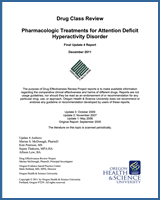NCBI Bookshelf. A service of the National Library of Medicine, National Institutes of Health.
McDonagh MS, Peterson K, Thakurta S, et al. Drug Class Review: Pharmacologic Treatments for Attention Deficit Hyperactivity Disorder: Final Update 4 Report [Internet]. Portland (OR): Oregon Health & Science University; 2011 Dec.
This publication is provided for historical reference only and the information may be out of date.

Drug Class Review: Pharmacologic Treatments for Attention Deficit Hyperactivity Disorder: Final Update 4 Report [Internet].
Show detailsLimitations of this Review
The results of this review are summarized in Table 17, below. As with other types of research, it is important to recognize the limitations of this systematic review. These can be divided into those relating to generalizability of the results and those relating to methodology within the scope of this review. The generalizability of the results is limited by the scope of the key questions and inclusion criteria, and the generalizability of the studies included. The great majority of studies included narrowly or poorly defined patient populations who met strict criteria for case definition, had few comorbidities, and used few or no concomitant medications. One concern about this group of studies is the variation in diagnostic criteria, particularly comparing studies conducted recently to those conducted in previous decades. Another concern is the handling of subtypes of ADHD in these studies. While many studies identify the proportions of patients diagnosed with various subtypes, stratification or analysis of the results based on these is lacking. Similarly, common comorbid conditions are not well addressed by the studies. In large part, the failure to address either subtypes or comorbidities may be due to small sample sizes involved in most studies, but these are serious shortcomings that should not be ignored. The failure of these studies to assess the effect of prior medication exposure or concurrent treatment with other psychoactive medications on outcomes is another serious issue, particularly when comparing older studies where very few patients had prior exposure to newer studies where large proportions did have exposure. Minorities and the most seriously ill patients were underrepresented.
Table 17
Summary of the evidence.
Methodological limitations of the review within the defined scope include the exclusion of studies published in languages other than English, and the lack of a specific search for unpublished studies.
Applicability
The evidence in preschool-age children is most applicable to White boys, ages 4 to 5, with moderately severe symptoms. The evidence base is very small such that characterization of the studies beyond this is not possible, most do not report the proportions with specific subtypes of ADHD or comorbidities.
Studies of elementary school age children with ADHD were characterized by underreporting of baseline subtype classifications, race or ethnicity, co-occurring disorders, and illness severity, although ore recent studies report these data more consistently. Only one-quarter of all studies of school-aged children reported ADHD subtype prevalence rates. The mixed subtype was most common, occurring in 58% to 100% of participants across most study populations. The inattentive subtype was generally observed less frequently (prevalence rate range: 9% to 40%) and the hyperactive subtype was relatively rare (prevalence rate range: 1% to 8%). Only one-half of all studies of elementary school-aged children reported race or ethnicity among the baseline characteristics. The racial/ethnic make-up of the majority of these study populations was consistent with the current United States Census Bureau Estimates (White = 80.4%; Black = 12.8%; Asian = 4.2%; and of Hispanic/Latino origin = 14.1%).400 However, the prevalence of ADHD among ethnic groups may not correlate with these data. The evidence applies best to children 8 to 9 years old.
Just over half of studies reported prevalence rates of co-occurring disorders, including oppositional defiant disorder (19% to 66.7%), conduct disorder (9% to 38.5%), anxiety (1.4% to 42%), and depression (0.7% to 6.6%). With the exception of depression, the ranges of comorbidities reported in these trials encompass the American Academy of Pediatrics estimates on prevalence of common comorbidities: Oppositional defiant disorder, 35%; conduct disorder, 26%; anxiety disorder, 26%; and depressive disorder, 18%.359 Illness severity was not presented as a baseline characteristic in most studies, and comparisons across studies based on scales used to assess symptoms are hampered by variation in scale choice and method of reporting. Diagnostic processes also varied across studies. Seventy-two percent of studies used either the DSM III, DSM III-R, or DSM IV criteria to diagnose ADHD, however many used additional criteria and the clinical comparability of patients enrolled is not clear.
The evidence in adolescents, although limited, is more diverse. While many studies reflect populations that are mainly white boys (mean age 14) with moderate to severe symptoms, a few studies included populations with close to 50% girls and 50% boys, and higher percentages of non-white teens. The combined type of ADHD was more prevalent; however few studies reported this characteristic.
In adults, studies generally included populations in their mid-thirties that were fairly balanced in terms of sex. However, studies in adults were also characterized by under-reporting of baseline ADHD subtype classifications, race or ethnicity, and co-occurring disorders. In the small number of trials that reported these data, race was predominantly white, but prevalence varied widely for the inattentive and combined subtypes of ADHD and for co-occurring disorders.
- Summary - Drug Class Review: Pharmacologic Treatments for Attention Deficit Hype...Summary - Drug Class Review: Pharmacologic Treatments for Attention Deficit Hyperactivity Disorder
Your browsing activity is empty.
Activity recording is turned off.
See more...